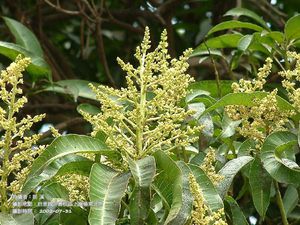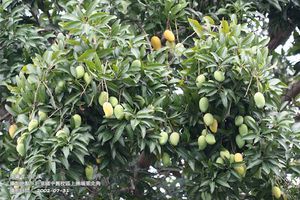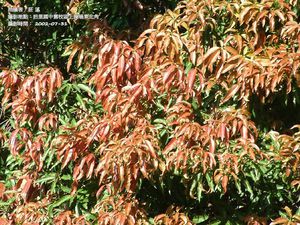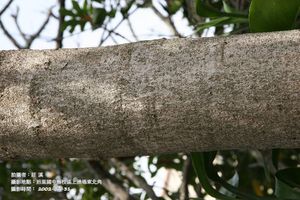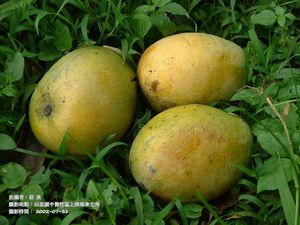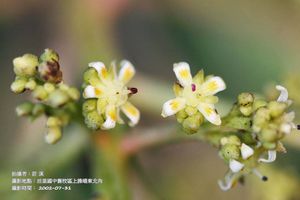檬果(芒果)
出自台灣有毒中草藥毒性資料庫
| 中英文學名 | 科別 | 毒性 | 症狀 |
本品僅在少數人身上出現過敏反應,請安心食用。若食用後出現任何不適,請立即向醫師諮詢。
基本資料
|
科別 | 漆樹科Anacardiaceae |
|
屬名 | 芒果屬 Mangifera |
|
中文學名 | 檬果 |
|
拉丁學名 | Mangifera indica L. |
|
英文名稱 | Mango |
|
中文俗名 | 芒果,木羨 仔、杧果 |
植物圖片
|
芒果花 |
芒果 |
芒果新葉 | |
|
芒果莖 |
芒果2 |
芒果花2 |
檬果(芒果)簡介
芒果最早源自於東印度,目前已廣泛種植於世界各地。芒果品種眾多,台灣最常見且為人熟知的主要為愛文、金煌以及土芒果等品種。台灣本身自己並沒有原生種的芒果品種,土芒果的來源也是大約四百年前由荷蘭人自爪哇引進的品種。目前於台灣各地都可以看的到芒果樹的蹤跡,在中南部地區,芒果樹也常被栽種作為行道樹,因此要找到芒果樹並不難。另外,芒果其實不是學名,真正的學名應該稱作檬果才對。值得注意的是,台灣的另一種行道樹,果實外觀與土芒果非常相似,但是科屬不同,屬於毒性較強的夾竹桃科,該植物稱作海檬果或海杧果,常有民眾誤認而摘取食用,導致程度不一的心臟毒性發生。
外觀簡述
|
莖 | 常綠喬木,全株莖幹含白色乳汁,枝幹斜生或直立、呈褐色及綠色、光滑無毛,質地堅硬且有葉痕 |
|
葉 | 單葉互生、叢生於枝頂,葉面革質,葉脈略呈平行、中肋於正反兩面均隆起,葉片外觀呈倒披針形或倒卵形,有葉柄。葉長可達7-15公分,寬3-6公分。 |
|
花 | 花單性與兩性共存而同株,小形,徑6-7 mm,頂生圓錐花序,花多數,淡黃色。萼片4-5枚,脫落性;花瓣數與萼片同數,覆瓦狀排列;雄蕊4-5枚,通常著生於肉質花盤上;花盤存在,環形,雄蕊與花瓣插生於花盤之邊緣;雌蕊子房1室,偏斜形,無柄,花柱單一而側生。 |
|
果實 | 肉質核果大型,內果皮纖維質,其形態、大小、品質因品種而異,通常為橢圓形、腎臟形或倒卵形,長5-25 cm,闊1.5-10 cm。 |
產地
印度,馬來西亞。芒果目前為台灣最主要經濟水果之一,亦作為行道樹栽種。
使用情況
芒果目前為台灣最主要經濟水果之一,亦作為行道樹栽種。
活性成份
|
莖[2-7] |
|
|
乳汁[8] |
|
|
果實[9] |
|
活性研究
- 1. 果內核丙酮水萃物gallotannins,可抑制革蘭氏陽性菌(Bacillus subtilis, Bacillus amyloliquefaciens, Listeria monocytogenes, Staphylococcus aureus, Staphylococcus warneri)及大腸桿菌(Escherichia coli AW 1.7及Escherichia coli GGG 10)的生長,但gallotannins的抑菌作用可被二價鐵離子或其他種類的二價陽離子抑制[9, 10]。
- 2. 樹皮水萃取物中的芒果苷(mengiferin),為最主要有效抑制活性氧自由基(reactive oxygen species, ROS)產生及組織氧化性傷害的化合物[3, 11, 12],且果皮的萃取物可抑制心、肝及腎藏的脂質氧化及甲狀腺素和副甲狀線素分泌量上升[13]。
- 3. Mengiferin抑制花生四烯酸(arachidonic acid, AA)的代謝產物prostaglandin E2 (PGE2)以及leukotriene B4 (LTB4)產生,達到抑制發炎及疼痛的作用[14]。
毒性研究
芒果樹皮水萃取物目前已有市售產品販售,所含最主要成分為mengiferin,主要作為營養補充品使用。經體內體外試驗證明,此萃取物(體外200-5000 μg/plate, 體內50-2000 mg/kg/day)並不會對DNA以及懷孕母鼠造成傷害[15, 16]。在急性毒性研究上(20-2000 mg/kg),經口及貼皮給藥並未發現大、小鼠有副作用或致死的毒性產生,但是在腹腔注射給藥時,濃度200 mg/kg出現小鼠死亡的情況;在兔子致敏刺激試驗當中,並未發現芒果樹皮水萃取物對皮膚有刺激作用[17]。
- 症狀[18-20]
- 1. 眼眶週邊水腫periorbital edema
- 2. 臉部紅斑facial erythema
- 3. 廣泛性蕁麻疹 widespread urticarial
- 4. 呼吸困難dyspnoea
- 5. 口咽發癢oropharyngeal itching
- 6. 血管性水腫angioedema
- 有毒成分[24]
- 未知,可能為mengiferin[15, 16]
- 中毒劑量
- 1. 200 mg/kg以上,腹腔注射[17]
- 機轉
- 未知
- 皮膚毒性
芒果目前被確認的毒性反應主要為接觸性皮炎(contact dermatitis),通常是患者吃下未去皮的芒果或碰觸芒果樹幹之後才產生的中毒症狀,目前已有多起案例指出芒果確實會對某些人產生接觸性皮炎的症狀[18-21]。
毒性分級
參考文獻
1. 陽光、影子. 檬果、芒果,炎炎夏日,來碗透心涼的芒果冰吧! http://digiarch.sinica.edu.tw/content.jsp?option_id=2442&index_info_id=3884.
2. Anjaneyulu V, Babu JS, Connolly JD. 29-Hydroxymangiferonic Acid from Mangifera-Indica. Phytochemistry 1994; 35: 1301-1303.
3. Selles AJN, Castro HTV, Aguero-Aguero J, Gonzalez-Gonzalez J, Naddeo F, De Simone F, Rastrelli L. Isolation and quantitative analysis of phenolic antioxidants, free sugars, and polyols from mango (Mangifera indica L.) stem bark aqueous decoction used in Cuba as a nutritional supplement. Journal of Agricultural and Food Chemistry 2002; 50: 762-766.
4. Khan MN, Nizami SS, Khan MA, Ahmed Z. New saponins from Mangifera indica. Journal of natural products 1993; 56: 767-770.
5. Anjaneyulu V, Satyanarayana P, Viswanadham KN, Jyothi VG, Rao KN, Radhika P. Triterpenoids from Mangifera indica. Phytochemistry 1999; 50: 1229-1236.
6. Anjaneyulu V, Prasad KH, Ravi K, Connolly JD. Triterpenoids from Mangifera-Indica. Phytochemistry 1985; 24: 2359-2367.
7. Anjaneyulu V, Ravi K, Prasad KH, Connolly JD. Triterpenoids from Mangifera-Indica. Phytochemistry 1989; 28: 1471-1477.
8. Bandyopadhyay C, Gholap AS, Mamdapur VR. Characterization of Alkenylresorcinol in Mango (Mangifera-Indica L) Latex. Journal of Agricultural and Food Chemistry 1985; 33: 377-379.
9. Engels C, Knodler M, Zhao YY, Carle R, Ganzle MG, Schieber A. Antimicrobial activity of gallotannins isolated from mango ( Mangifera indica L.) kernels. J Agric Food Chem 2009; 57: 7712-7718.
10. Engels C, Ganzle MG, Schieber A. Fractionation of Gallotannins from mango (Mangifera indica L.) kernels by high-speed counter-current chromatography and determination of their antibacterial activity. J Agric Food Chem 2010; 58: 775-780.
11. Pardo-Andreu GL, Dorta DJ, Delgado R, Cavalheiro RA, Santos AC, Vercesi AE, Curti C. Vimang (Mangifera indica L. extract) induces permeability transition in isolated mitochondria, closely reproducing the effect of mangiferin, Vimang's main component. Chemico-biological interactions 2006; 159: 141-148.
12. Pardo-Andreu GL, Barrios MF, Curti C, Hernandez I, Merino N, Lemus Y, Martinez I, Riano A, Delgado R. Protective effects of Mangifera indica L extract (Vimang), and its major component mangiferin, on iron-induced oxidative damage to rat serum and liver. Pharmacol Res 2008; 57: 79-86.
13. Parmar HS, Kar A. Protective role of Mangifera indica, Cucumis melo and Citrullus vulgaris peel extracts in chemically induced hypothyroidism. Chemico-biological interactions 2009; 177: 254-258.
14. Garrido G, Gonzalez D, Lemus Y, Delporte C, Delgado R. Protective effects of a standard extract of Mangifera indica L. (VIMANG) against mouse ear edemas and its inhibition of eicosanoid production in J774 murine macrophages. Phytomedicine 2006; 13: 412-418.
15. Rodeiro I, Cancino L, Gonzalez JE, Morffi J, Garrido G, Gonzalez RM, Nunez A, Delgado R. Evaluation of the genotoxic potential of Mangifera indica L. extract (Vimang), a new natural product with antioxidant activity. Food Chem Toxicol 2006; 44: 1707-1713.
16. Gonzalez JE, Rodriguez MD, Rodeiro I, Morffi J, Guerra E, Leal F, Garcia H, Goicochea E, Guerrero S, Garrido G, Delgado R, Nunez-Selles AJ. Lack of in vivo embryotoxic and genotoxic activities of orally administered stem bark aqueous extract of Mangifera indica L. (Vimang). Food Chem Toxicol 2007; 45: 2526-2532.
17. Garrido G, Rodeiro I, Hernandez I, Garcia G, Perez G, Merino N, Nunez-Selles A, Delgado R. In vivo acute toxicological studies of an antioxidant extract from Mangifera indica L. (Vimang). Drug Chem Toxicol 2009; 32: 53-58.
18. Hegde VL, Venkatesh YP. Anaphylaxis following ingestion of mango fruit. J Investig Allergol Clin Immunol 2007; 17: 341-344.
19. Weinstein S, Bassiri-Tehrani S, Cohen DE. Allergic contact dermatitis to mango flesh. Int J Dermatol 2004; 43: 195-196.
20. Miell J, Papouchado M, Marshall AJ. Anaphylactic reaction after eating a mango. BMJ 1988; 297: 1639-1640.
21. Hershko K, Weinberg I, Ingber A. Exploring the mango-poison ivy connection: the riddle of discriminative plant dermatitis. Contact Dermatitis 2005; 52: 3-5.
| 中英文學名 | 科別 | 毒性 | 症狀 |
